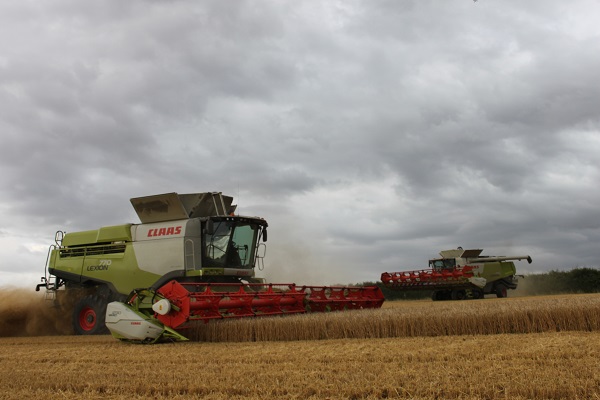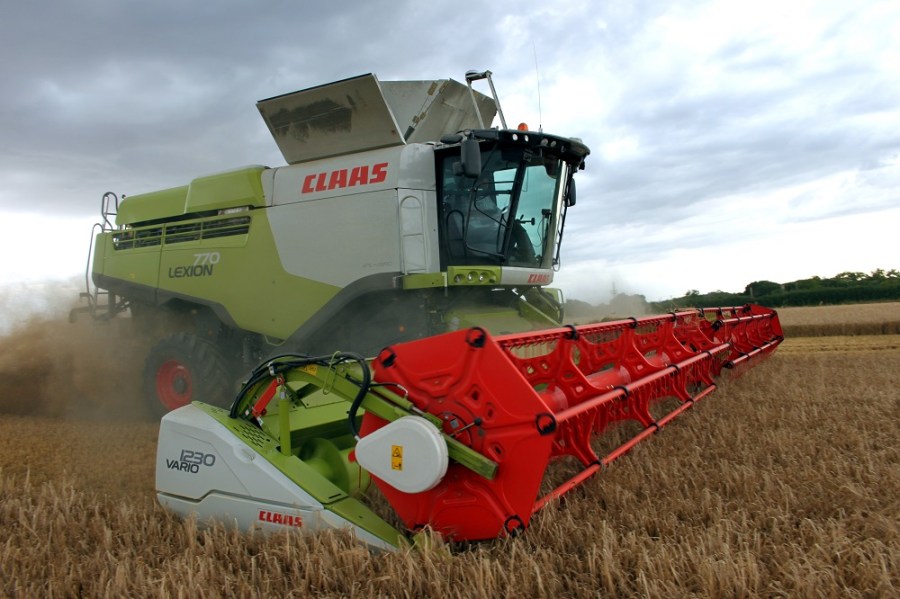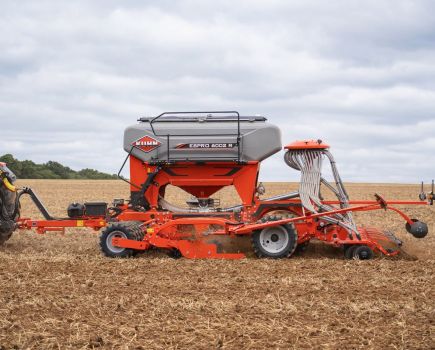To really appreciate the developments on Claas’ new Lexion 700 combines, you have to run one alongside an older model. CPM visits a Cambs estate doing just that.
With around £300,000 of premiums in the balance with our milling and malting crops, it’s important we cut at optimum quality.
By Martin Rickatson
Cast your eye over a 2015-16 model year Claas Lexion 700 series hybrid combine, and you’d be hard-pressed to spot significant differences between it and one of its immediate predecessors, which carried the same model numbers.
Yet on the inside, a number of updates were made to the drum-and-concave/twin separation rotor machines in time for this past harvest.

With both superseded and current (foreground) Claas Lexion 770 combines on its fleet, Bartlow Estate has been able to gauge the value of recent upgrades.
These bring not only more power and greater grain tank capacity, but also a new cleaning system, optional Automatic Crop Flow shaft speed monitoring system and a number of chopper improvements.
While the market as a whole was able to buy upgraded 700 series Lexions in time for harvest 2016, a handful of farms were offered the opportunity to purchase one of the pre-production machines during their launch season last year. Now with two harvests under their belts, it was one of those combines with which CPM caught up during summer 2016.
Operating two models
Cambs-based Bartlow Estate is a long-term hybrid Lexion customer, having run the machines since their mid-1990s introduction. With over 2000ha of combinable cropping to cover, comprising a season-long spread from winter oilseed rape through winter wheat and spring barley to spring beans and linseed, plus a fairly strung-out spread of land, a single top-of-the-range machine wouldn’t be capable of the full workload, points out farm manager Jason Turnbull, so the business operates two models of the understudy in the Claas line, the Lexion 770. Key differences between the 770 and the 780 flagship are slight increases in horsepower, separation area and grain capacity.

When working up or down slopes, the 4D system automatically adjusts fan speed according to the angle, although this requires some fine-tuning in OSR.
“We’ve long run two combines, always working them together as a pair, in conjunction with a chaser bin and our own team of lorries,” he explains.
“With a single, large grain store and a continuous-flow dryer, we find this system works best for us. When the 600 and 770 Lexion models were the flagships of the range, we ran them, but as Claas continued to increase the size of its top model, we’ve found we’re happy to stay with the power, grain-tank size and separation area of the 770, even though the 780 is now available and has marginally more of each.
“Until summer 2015, we were running a 600 and a 770, with the older machine hired and the newer one owned. But prior to harvest 2015, knowing we had a good deal of experience with the 770, Claas offered us the opportunity to purchase one of the pre-production upgraded 770s to provide final feedback ahead of the launch for the 2015-16 sales year, and we accepted. So we retained our existing 2011 770 and since harvest 2015 have been running two owned combines, which also now gives us better forecasting of ownership and running costs.”
The move has meant the farm has two machines with the same model number on the sides, but the specification of the combines is different in a number of key areas. First up is the engine – while both powerplants come from Mercedes-Benz, the new/current model’s motor is a 15.6-litre straight six-cylinder unit, in place of the old 16-litre V-8, producing a higher rated power output at lower rated speed and 34hp more maximum output.
Although Dynamic Cooling wasn’t new to last year’s 770 models, the farm’s existing 770, an early model, didn’t have this feature, and the business also benefited from this upgrade on the new machine. The system uses a variable fan drive that works on demand, providing only the cooling capacity actually required at any time and saving a claimed 15-20hp.
A fan/filter package lying horizontally on top of the engine bay draws air from the clean zone above the combine into the radiator, forcing it downwards over the engine before it exits through louvred side panels. This creates an air ‘curtain’ which flows down the side of the combine to actively prevent dust rising, ensuring clean air is being continuously drawn into the engine and keeping the engine bay area cleaner, claims Claas.
The other significant introduction among last year’s Lexion 700 series revisions was the new Claas 4D cleaning system. The firm has long offered a 3D system to level the upper sieves when working across slopes to avoid overloading the downhill side of the sieves, but 4D has added two key components – a slope-dependent rotor cover-plate control and automatic fan control.
On combines specified with 4D cleaning, an extra third pair of rotor cover-plates is fitted to the Roto Plus rotors, which are divided in two. These are automatically adjusted according to the lateral and longitudinal angle of the combine, but with the current separation and cleaning output also taken into account.
As the combine angle changes, the cover plates on the up-hill side of the rotor are automatically opened or closed. When the combine is working directly up or down the slope, the 4D system also automatically adjusts fan speed dependent on the angle, reducing the wind speed when working uphill and increasing the speed on the way down, in addition to adjusting the lower sieve.
Among the other upgrades was the integration of the optional CEMOS manual or automatic performance-maximising system into the main CEBIS control terminal, and a 300-litre boost in grain-tank capacity on the 770 to 12,800 litres. Meanwhile, a new, slightly wider 12.3m cutterbar gives more margin when precisely cutting 12m bouts, particularly for those practising controlled traffic farming.
Lastly came the new Claas Automatic Crop Flow option. With many farms at this end of the combine market looking for maximum productivity from their machines, Claas says its engineers identified that many were working under high load for much of each working hour. The firm says it therefore developed ACF to monitor and compare the working speeds of key components including the engine, APS primary separation and Roto Plus secondary separation systems.
Rotor slip levels
The system allows the operator to set preferred rotor ‘slip’ levels using CEBIS, and should this be exceeded an alert is provided and cutterbar and elevator drives are shut down, while the cutterbar brake is engaged, the unloading auger disengaged if active and the Cruise Pilot cruise control set to minimum speed. ACF is designed, says Claas, to allow operators to push combines to their intake limits knowing the risk of blockage occurring is minimal.
“With around £300,000 of premiums in the balance with our milling and malting crops, it’s important we cut at optimum quality, and the only way to guarantee that is to have plenty of combine capacity,” explains Jason Turnbull.
“And getting crop off the field promptly means more time to achieve good quality cultivations and sound crop establishment. So combine capacity isn’t just about acreage.”
To keep the two machines operating at maximum productivity, the business runs one of Quivogne UK’s Perard Interbenne 30t chaser bins – which replaced a pair of smaller Horsch units and is operated by a Fendt 939 – to fill a fleet of four farm artic trucks.
“We soon noticed the difference in the combine engines. As well as more power the new one produces more torque, meaning the engine doesn’t die back when unloading on the move with the combine at full capacity, enabling the machine to continue at exactly the same pace, where it can be necessary to ease back on the stick with the old model.
“We use the Claas Telematics package to enable performance to be monitored directly from the farm office, and as a tool to plan refuelling. In 9-10t/ha wheat the new 770 averaged 58t/h using 76 litres/h of diesel when chopping, compared to 52t/h using 82 litres/h on the older machine – a difference of 17% or 0.27 litres/t.”
Head combine driver Neil Hutchinson operated the farm’s other 770 before last year taking the operator’s seat of the new machine and handing his five-year-old combine to fellow driver Callum Ross. He reckons that aside from the more efficient engine, the new 4D cleaning system has proved particularly beneficial among the new series upgrades.
“Although we’re in Cambs, we do have some banks, and on side slopes the new 770 combine will retain its pace while keeping losses within limits, while with the older model it’s often necessary to ease back by at least 0.5km/h to do that. Switching 4D off on a slope sees losses immediately start to climb and the sample start to suffer. And fan speed is much faster to react when driving into and out of a dip.
“But the system does need fine-turning in OSR – increased fan speed might be desirable when working downhill in wheat, but not in OSR.”
He’s also found the hydraulic cover plate ‘bomb doors’ on the first two of the five rotor concave pairs beneath the two separation rotors to be particularly useful in some situations.
“If we’re in dry, brittle straw I can close them up so the sieves don’t become overloaded, and I can consistently get a good sample.”
The reassurance provided by the Automatic Crop Flow shaft speed monitoring system has also helped to exploit the greater potential of the combine, suggests Neil Hutchinson.
“Knowing it’s there has given me a lot more faith to really push the combine on in the knowledge I’m unlikely to block the machine. By coupling this with making more use of the Cruise Pilot feedrate control, I can raise outputs by around 5-7t/h, and bring average output rates closer to spot rates. And having the ground proximity sensors now in the centre of the header on the new 12.3m cutterbar has also helped here, cutting out any bulldozing issues.
“We run both combines off a basic free GPS signal, with both set to cut at 11.6m. Once I’ve set an A-B line, that’s shared with the other combine, and we can work fairly precisely with matched bouts, despite the slight difference in actual header widths. Being compatible with the Russian GLONASS satellite network as well as the US GPS one, the steering system retains signal well, and we’ve had it retro-fitted to the older 770. Previously, we had used the Laser Pilot system, but we find this does have limitations in very dusty conditions.”
Neil Hutchinson also reserves praise for the improvements Claas has made to straw-chopper control, with more fine-tuning now possible through the CEBIS monitor alleviating any need to leave the cab when making changes.
“It’s helped improve quality of the spread pattern, meaning I can easily engage the baffle plate if a really fine chop is required. And I can also make a full switch between swathing and chopping from the seat – there’s no need to leave the cab for any reason and get covered in dust.”
Another 300 litres of grain tank capacity seems fairly marginal on a machine of this size, but it has added valuable seconds to an under-pressure chaser operator, Neil Hutchinson suggests.
“Having that little bit more tank space gives our chaser-bin driver just a little more time to take his loads from both combines, empty into a lorry and return,” he says.
“And that can help prevent one of us having to wait for him to get back because we’ve filled the grain tank in the meantime. Unloading time on the new machine is also impressive, again helping in this department.”
Meanwhile, it wasn’t just the combines themselves Claas reckoned to have improved in time for this past season. Back onto the drawing board went the firm’s trailer design for its largest headers, and Neil Hutchinson says he has also been impressed here.
“Despite being longer, the new pre-production four-wheel steer trailer that was supplied with the combine is much more manoeuvrable. I’ve been really surprised by the places we’ve been able to get it into, and that helps to significantly speed up moves between fields.”
Farm facts
Bartlow Estate, Cambridge
- Farm size: 2000ha of cropping
- Soils: Hanslope series chalky boulder clay
- Cropping: Winter wheat (feed and milling), winter oilseed rape, spring barley (malting), spring beans, spring linseed, sugar beet
- Mainline tractors: Case IH Quadtrac 600 and 530, Fendt 939, New Holland T7.270, Massey Ferguson 7624
- Combines: 2015/16 (pre-series) Claas Lexion 770TT with 12.3m Vario header, 2011 Claas Lexion 770TT with 12.0m Vario header
- Grain haulage: 30t capacity Perard Interbenne chaser bin feeding own artic trucks
- Main cultivation equipment: 7m Väderstad TopDown, 12f Gregoire Besson plough, 10m Väderstad Rexius Twin
- Drill: 8m Väderstad Rapid with Cultivating Solutions toolbar
- Sprayers: 40m Agrifac Condor 3 plus 36m Bateman RB25




